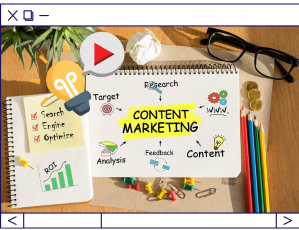How Content Marketing Helps Your Business
In today’s ever-changing, ever-expanding digital landscape, content marketing is widely considered a powerful tool for businesses! The chance to connect with the target audience, establish your credibility in your business niche, and drive favorable customer actions are why your business needs content marketing.
But it’s essential to know what content marketing is to maximize its benefits for your business. Content marketing, as a form of strategic marketing (i.e., long-term), creates and distributes relevant, valuable, consistent content to attract, engage, and retain a specific target audience. Its primary goals are building trust, establishing authority and driving consumer action, which can be making purchases or patronizing a service, among other desired actions.
Examples of content marketing are blog posts, infographics, videos, podcasts, ebooks and whitepapers, social media pages and posts, case studies, videos, webinars and live streams, user-generated content, email marketing, surveys and research reports, knowledge base articles and FAQs, and interactive content (e.g., quizzes and polls).
While content marketing and advertising have similarities, these are different in many aspects. Contrastingly, content marketing provides value to and builds relationships with its target audience instead of directly promoting products or services. On the other hand, advertising can be a hard sell, meaning it’s more sales-driven with more focus on getting immediate results.
10 Benefits of Content Marketing for Business Growth

Keep in mind that the reasons why your business needs content marketing are closely related; thus, creating content for marketing purposes must be made with a holistic mindset. You must remember the modern adage from Bill Gates’ 1996 seminal article of the same name – Content Is King – because it still applies in 2023! Both Internet users and Google, after all, love quality content!
Build Brand Awareness, Recognition and Recall
By delivering content that is relevant and useful to your target audience, you draw the attention of people unaware of your business and brand. When your readers engage with your content, such as commenting on your social media posts and sharing them with their network, your brand’s visibility in the digital landscape increases. You can build brand awareness and, consequently, brand recognition and recall with every engagement!
Your business can also be more widely known by targeting specific keywords and topics that, in turn, will result in content optimization. You must create content aligned with the search queries your target audience actively searches for and, thus, allow your brand’s content to appear on the first pages of search engine results.
Studies have shown that the first page of Google captures more than 70% of clicks among Internet users, meaning it’s crucial to rank first in your targeted keywords in content marketing. Just 0.63% of Internet users click on the second and subsequent pages – instead, their next action will likely be changing their queries! Talk about missed opportunities.
Content marketing with visual elements, such as videos, infographics and images, can be more effective in attracting the attention of your target audience. Images make your brand more shareable and memorable, boosting brand awareness – the more people see your brand-associated images, the more recognition and recall possible.
You can also provide more information about your industry in general and your business and its products and services through content marketing. Think of it as a vital step in establishing positive perceptions and feelings about your brand, and you will double down on the quality and delivery of your content.

Establish Thought Leadership in Your Industry
Thought leadership refers to the recognition that individuals and organizations receive for their expertise, innovation and influential thinking. The depth and breadth of their knowledge, combined with their unique and useful insights, provide others with valuable perspectives, drive conversations toward new directions, and provide guidance on the opportunities and challenges in their industries.
Like content marketing, thought leadership also provides value to the target audience through informative, enlightening and thought-provoking content. Both content marketers and thought leaders use a wide range of media, from articles, whitepapers and research studies to social media posts and videos, webinars, and even public speaking engagements. Both also share the common goals of education, inspiration and influence that positively impact their industries and broader communities.
If you become a thought leader in your business through effective content marketing, you can establish credibility and authority in your industry. Being a credible and authoritative source of information attracts potential customers, partners and investors that will contribute to your business’ growth.
Being a thought leader will also set your business and brand apart, providing a competitive edge in a digital landscape with more than 200 million active websites. The general public will also regard your willingness to share your knowledge and insights through content marketing channels in a positive manner. You will agree that goodwill may be an intangible asset, but it’s a sought-after asset in business regardless of size and scope.
Thought leadership is also crucial to resilience and adaptability in industries where disruptions, particularly technological disruptions, are constantly challenging. Media and entertainment, technology products and services, financial services, telecommunications, retail, and education are among the industries most susceptible to digital disruptions. The effective and efficient use of content marketing in business, particularly establishing thought leadership, reduces the negative impact of these disruptions.

Generation of Organic Traffic and Optimization of SEO
Search Engine Optimization (famously, SEO) and content marketing are closely intertwined, thanks partly to the fact that Google recognizes quality content in its algorithms. When your business-related, high-quality content is optimized for relevant keywords, its chances of ranking higher in the search engine results pages (SERPs) are higher. The higher your ranking, the greater your opportunities to attract more organic traffic, the more brand awareness you can maximize, and the more opportunities to drive consumer behavior!
When using content marketing to promote a business in the digital landscape, you should consider long-form and evergreen content pieces alongside short-form content. Comprehensive tutorials, guides, and in-depth articles effectively boost organic traffic over a long period while attracting backlinks from other reputable websites.
Aside from optimized keywords, descriptions and meta tags, other effective organic traffic and SEO practices include internal links for search engine indexing and user navigation and engagement, regular content updates, and backlink optimization. Be sure that your business website and pages are optimized for mobile use, too, and that you’re using user engagement metrics.

Foster and Engage Business Prospects
The best content marketing in business settings addresses the target audience’s pain points, provides solutions for their issues, and answers their questions. In doing so, your business can establish a meaningful connection with its business prospects that, with effective follow-up content, results in more engagement. Said engagement can take many forms, from sharing your blog posts to recommending your products/services and making repeat purchases, but every positive action builds on each other.
Keep in mind that it’s critical to remarket and retarget your content so that you can continue engaging your business prospects. You want your business to stay top-of-mind and allow consistent contact via repeated touchpoints. Suffice it to say that with the competitive digital landscape, customer attraction is only half the battle – the war is constantly won via customer retention!
There are many ways of achieving customer retention through content marketing, too. Think of message personalization, where your content caters to the specific preferences of your business prospects, meaning it will resonate with them on a more personal level. Get lead magnets out there, adding value to your content (e.g., exclusive reports and whitepapers sent via emails). Use drip campaigns and allow two-way communications between your business and its prospects.

Attract Leads, Drive Conversions and Sustain Sales
When you promote business with content marketing, you acknowledge its significant impact on attracting leads, stimulating conversions and customer actions, and encouraging repeat product purchases or service patronizations. But it’s critical to create informative and persuasive content that will influence the decision-making process of your target customers!
Why are these three aspects crucial to your business’ success? First, attracting leads is the first step in building your customer base, increasing brand visibility and expanding its reach. Note that leads are potential customers whose interest in your products and services must be sustained for conversion purposes.
Second, conversions refer to turning potential customers into paying customers. Think of conversions as your business’ lifeblood because of the cash flow (i.e., revenue generation) these bring, not to mention that conversions represent excellent growth opportunities. Indeed, it isn’t enough to create a large pool of potential customers – every single one should be converted!
Third, even with every potential customer taking your desired action, sustaining their positive actions is even more crucial. Sustaining sales isn’t just about consistent cash flow through repeat purchases, either! You will find that retaining existing customers is more cost-effective than getting new customers, and loyal customers become your brand customers, too (i.e., word-of-mouth advertising).
Together, these three interrelated benefits of content marketing create a sustainable revenue stream that contributes to your business’s profitability and sustainability. Enjoying these benefits requires putting product- or service-focused content on your business website, including clear and prominent calls-to-action and leveraging social proof, among other strategies.

Encourage Customer Loyalty and Retention
Customer retention refers to the metric that measures customer loyalty (i.e., keeping customers over time). Aside from determining the number of customers loyal to the brand, as well as its products and services, customer retention is also used in determining the level of customer satisfaction and engagement, as well as their repurchase behavior and emotional ties.
Of course, customer retention is a cycle in itself – once a customer buys your products or patronizes your services, they must make a repeat purchase and perform other desired actions. If your analysis reveals a drop in customer retention, you must determine its root cause and adjust.
Customer retention is crucial because of its cost-effectiveness. As previously mentioned, the cost of new customer acquisition is significantly higher than customer retention and the brand ambassador role that existing customers assume is priceless.
Effective content marketing comes into the picture when it provides targeted education for your potential and presents customers with your brand and its products and services.Implement content marketing strategies to keep them satisfied with their purchases, strengthen their positive customer experiences, and encourage them to return to your business for updates and more purchases.
These benefits aren’t just anecdotal, either! According to research conducted by Harvard Business School, just by improving customer retention rates by about 5%, a business can grow its profits by as much as 95%! This makes sense, too, considering that businesses are 40% more likely to achieve conversions from customers who have already made an initial purchase than for these companies to make new conversions.
Consider that 65% of your business is likely made up of existing customers, and you will agree that customer retention makes business sense. But it must also be emphasized that customer acquisition and retention are crucial for business success and, thus, must be balanced fairly.
Effective ways of achieving customer retention through content marketing include incentivizing loyalty (e.g., loyalty programs, credit, and discounts), gathering customer feedback for more personalized content and experiences, and improving customer support services.

Improve Social Media Presence and Engagement
With the prevalence of social media, it makes good sense to promote business with content marketing on social media sites. There are 4.80 billion users on social media sites, and your business can tap into its potential without even getting up from your seat! Indeed, social media presence and engagement are necessary for every small business that wants to make it big and for big businesses to keep their lead.
Social media engagement refers to the number of public shares, likes and comments your business-related social media efforts generate. Each of the most popular social media sites has its mechanisms for engagement, and each site also measures engagement differently. Twitter uses followers and retweets; Facebook uses followers, shares and likes, as well as mentions and messages; and Instagram uses followers and likes.
But there are also other ways to measure your digital presence beyond these three juggernaut social media networks. Interactions with your page (e.g., tab clicks, profile clicks, and call-to-action button clicks) and interactions with other pages (e.g., page mentions and comments) are notable examples.
Why are social media and digital engagement important in your business’ success? Because the social media platforms and search engines say, it is so! You’re more likely to generate organic traffic if your business website has higher social media and digital engagement – and meaningful engagement.
Both potential and present customers also love seeing and sharing positive interactions between businesses and people. But it isn’t just enough for people to see positive public interactions either – people expect positive experiences in private, too, such as quick responses to Facebook messages. Even answering a simple complaint promptly and appropriately can increase customer advocacy by 25% – and answering complaints and questions is part of effective content marketing.

Expand Reach and Increase Sphere of Influence
In the business world, a sphere of influence refers to the geographical area, a network of people and organizations, and market reach in which an organization has significant control, power and impact. Both direct and indirect influence is considered in determining your sphere of influence, and it can include your business’ influence on the reputation, actions and decisions of these third parties.
For example, if you’re a small business owner, your sphere of influence will likely be limited to your immediate neighborhood or niche; as your business grows, your sphere of influence expands. Your sphere of influence is also stronger and wider when you have satisfied customers, are a thought leader in your industry or niche, and have established meaningful partnerships and alliances. Your sphere of influence also benefits from positive media and public relations and a strong online presence characterized by a well-designed website with valuable content and meaningful social media engagement.
And you guessed it – effective content marketing strategies are crucial in establishing, strengthening and expanding your sphere of influence!

Fuel Inbound Marketing
Among the best customer-centric marketing strategies, inbound marketing focuses on attracting and engaging prospective customers, investors and stakeholders through relevant, valuable and informative content. The next step is turning these leads into loyal customers whose brand advocacy can generate more new leads and prospects – and the cycle starts again.
As implied, content creation is a crucial aspect of inbound marketing – the more valuable the content is for the target audience, the more successful inbound marketing will be. Yet another critical aspect of inbound marketing is buyer persona, or the detailed characteristics of target customers, including their demographics, pain points, and interests. These buyer personas are also crucial for effective content marketing because they tailor content for the target audience.
Inbound marketing is also related to content marketing in that its primary goals include attracting potential customers instead of actively seeking them out. Like content marketing, inbound marketing achieves the goal through search engine optimization, content promotion, and social media marketing, making content valuable for its target audience and discoverable and shareable.
Once the target audience becomes engaged with content, the next step is capturing their contact information by offering valuable resources in exchange for newsletter subscriptions and email addresses. The content must be engaging in the first place for it to happen – and this is where well-thought-out content marketing strategies come in.
The bottom line: Content and inbound marketing feed on each other’s gains! This is true from lead generation to conversion optimization, customer satisfaction, retention, and brand advocacy.
We must also point out the relationships between content marketing and advertising, and inbound marketing. You can use interconnected strategies to attract, engage, and convert potential customers. While content marketing provides value vital in attracting and engaging target audiences, inbound marketing combines multiple strategies for customer attraction, conversion and retention over the long term. In both content marketing and inbound marketing, advertising is vital in the amplification of messages and the generation of immediate awareness.
When combined strategically, inbound marketing, content marketing and advertising form a powerful marketing strategy for your business, regardless of size, scope and status in the market.

Maximize Return on Investment
When you use content marketing to grow your business, you will likely maximize your return on investment! Return on investment is a financial measurement used to evaluate the cost-efficiency and profitability of business-related activities. These can be business initiatives, projects, and investments – or in the case of content marketing, the cost of the content created and distributed using your company’s resources.
With effective content marketing strategies, your business can enjoy higher returns on investment because of sustained sales over the short-term and long-term periods. With more cash flows, your business becomes more profitable and, more importantly, sustainable and scalable!
Effective Ways to Maximize Content Marketing for Your Business

But if you want to use content marketing to grow your business and reap its benefits, you must learn the techniques to maximize it!
Learn the Essential Aspects of Content Marketing First
Knowledge is power as much as content is king in the digital business landscape – and it starts with understanding the basics of content marketing.
- It’s an audience-centric approach, meaning general content won’t cut it. Your content must be specifically tailored to your target audience, and it involves understanding their preferences, pain points, and behaviors.
- Providing informative content that adds to the value of the target audience’s life is essential, such as providing answers or entertaining them.
- It isn’t a one-time, big-time effort either. Consistency is key in content marketing, and it demands retargeting and remarketing to appeal to the different stages of the customer’s engagement with your brand.
- It’s also about compelling and persuasive storytelling, whether telling your brand’s story or telling your customers’ stories through testimonials.
- It’s best implemented through multichannel distribution, meaning content must be on various platforms like your business website, social media sites, emails, and newsletters.
- It’s about effective and efficient search engine optimization – a different ball game altogether.
Use analysis and metrics to determine your content marketing strategy’s effectiveness, efficiency and responsiveness, too! Website traffic, customer feedback, and conversions are key performance indicators.
Make SMART Goals
SMART is an acronym used as a framework for setting clear and achievable goals, as follows:
S – Specific, meaning the goal should be well-defined by answering questions like, “What objectives do you want to achieve? Why are these important for your business? Who should be involved in their accomplishment?”
M – Measurable, meaning it must be quantifiable, making it easy to monitor. Measurement metrics used include dollars (how much), number of units (how many), and time (when should it be achieved), and these metrics allow for specific determination of whether you’re on track towards your goal.
A – Achievable, meaning the goal must be realistic and attainable with your current resources and skills considered in setting it.
R – Relevant, meaning it must be aligned with your overall objectives, values and aspirations.
T- Time-bound, meaning the goal must have a specific deadline and time frame to be monitored regularly.
With this in mind, your SMART content marketing goal can be:
Using content marketing strategies, increase organic website traffic by 25% from the previous quarter within the next three months.
Your goal must also be rooted in market research, such as an in-depth analysis of website traffic from the previous quarter.
Develop the Best Content Marketing Strategy Based on Your SMART Goal
The alignment between your content marketing strategy and the goal is crucial for success! While it may seem like an excellent idea to use all types of content marketing, it isn’t because of the cost factor – and we’re not talking about the dollar amounts either but also the time, energy and effort necessary to cover all bases in content management.
You must determine the best type of content for your current goal, such as videos or blog posts with infographics. You should also decide on the topics to be covered, the follow-ups, and the platforms to use. Since goals change over time, your content marketing strategy must change, too.
Content Marketing IS the Future!
Content Marketing is a powerful business tool! But like other business tools out there, its power lies in its effective and strategic implementation! You must learn how, why, and what makes it work before you can fully harness its power and reap its benefits for your business.

